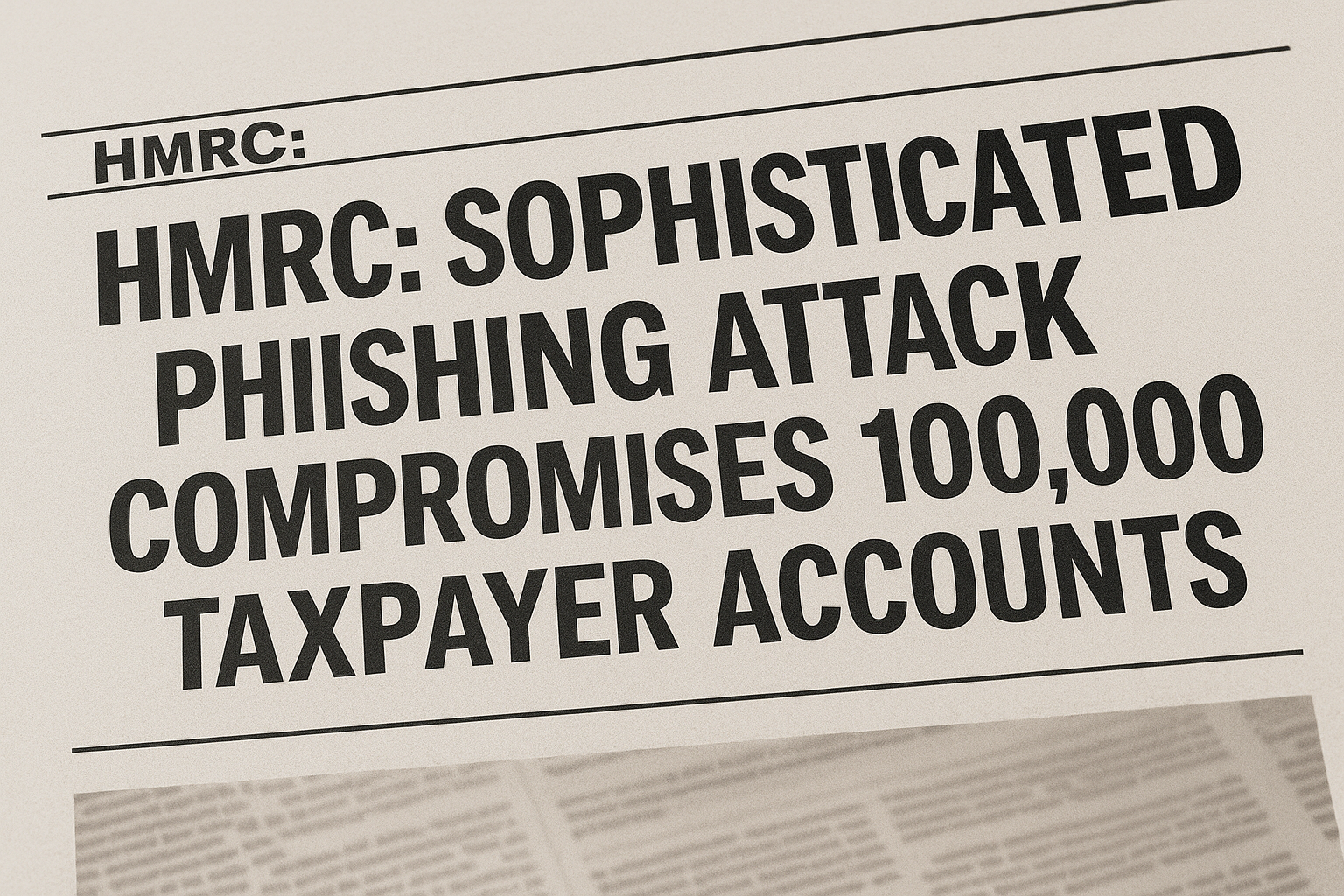
Author: AISECGEN
Date: 5th June 2025
Date of Attack: December 2024 – Ongoing
Sector: UK Government Tax Authority
Threat Actor: Organised Crime Syndicates
Executive Summary
Between December 2024 and continuing into 2025, HM Revenue and Customs (HMRC) fell victim to a sophisticated phishing attack that compromised approximately 100,000 taxpayer accounts and resulted in financial losses of £47 million. The incident was disclosed to Parliament’s Treasury Select Committee on 4th June 2025, nearly six months after the initial detection.
The attack involved organised crime groups using stolen personal data obtained from external sources to either access existing taxpayer accounts or create fraudulent PAYE (Pay As You Earn) accounts. Criminals then used these compromised accounts to submit false tax refund claims, successfully extracting £47 million from HMRC systems before the breach was fully contained.
This incident represents one of the largest financial losses to the UK tax authority through cybercrime and highlights significant vulnerabilities in taxpayer account verification processes.
Background
HM Revenue and Customs (HMRC) is the UK’s tax, payments, and customs authority, responsible for collecting taxes and administering various government support schemes. The organization manages approximately 50 million PAYE taxpayer accounts through its online services platform.
HMRC’s digital infrastructure handles billions of pounds in tax transactions annually and maintains sensitive personal and financial data for virtually all UK taxpayers and businesses.
Timeline of Events
| Time Period | Description |
|---|---|
| December 2024 | Initial phishing attacks begin targeting PAYE system |
| December 2024 – March 2025 | Ongoing fraudulent account creation and refund claims |
| March 2025 | HMRC detects suspicious activity and begins investigation |
| March-May 2025 | Internal investigation conducted with international cooperation |
| May 2025 | Compromised accounts locked down and security measures implemented |
| June 4, 2025 | Public disclosure to Treasury Select Committee |
| June 5, 2025 | Media coverage and parliamentary criticism begins |
Technical Details
Attack Vector:
- Phishing campaigns using personal data obtained from external breaches
- Social engineering techniques to bypass account verification
- Credential stuffing attacks using previously compromised credentials
- Creation of fraudulent PAYE accounts using stolen identities
Threat Actor:
- Multiple organized crime syndicates operating internationally
- Financially motivated actors with sophisticated operational capabilities
- Groups demonstrated knowledge of UK tax system processes
- International investigation led to arrests in 2024
Attack Methods:
- Used stolen personal data to impersonate legitimate taxpayers
- Created fake PAYE accounts or gained access to existing accounts
- Submitted fraudulent tax refund claims through compromised accounts
- Exploited weaknesses in account verification processes
Affected Systems and Services
| System | Description | Status |
|---|---|---|
| Online Tax Accounts | Individual taxpayer portal access | Compromised accounts locked |
| PAYE System | Pay As You Earn tax collection platform | Enhanced security implemented |
| Refund Processing | Automated tax refund payment system | Additional verification controls added |
| Account Verification | Identity verification for new accounts | Strengthened authentication required |
| Customer Communications | Taxpayer notification systems | 100,000 affected individuals contacted |
Recovery operations are ongoing with enhanced security measures now in place across all affected systems.
Data Exposure
The incident involved unauthorized access to:
- Personal taxpayer information including names and addresses
- National Insurance numbers and tax reference codes
- Employment and income data from PAYE records
- Bank account details used for refund payments
- Tax calculation and refund history information
Estimated Data Volume: Personal data of approximately 100,000 UK taxpayers
The Information Commissioner’s Office (ICO) has been notified of the breach in accordance with UK GDPR requirements.
Impact Assessment
- Financial Loss: £47 million stolen through fraudulent refund claims
- Affected Individuals: 100,000 taxpayers (0.2% of PAYE population)
- Account Lockdowns: All compromised accounts secured and locked
- Operational Disruption: Enhanced verification processes causing service delays
- Reputational Damage: Parliamentary criticism over delayed disclosure
- Regulatory Scrutiny: ICO investigation and Treasury Committee oversight
- Individual Impact: Taxpayers face account lockouts and potential identity theft risks
HMRC has stated that affected taxpayers will face “no financial loss” as the organization takes responsibility for the stolen funds.
Response and Recovery
Immediate Actions:
- All compromised accounts immediately locked down
- Enhanced multi-factor authentication implemented
- Additional verification requirements for new account creation
- Strengthened refund processing controls deployed
Investigation and Cooperation:
- Internal forensic investigation conducted
- International law enforcement cooperation initiated
- Multiple arrests made in 2024 in related jurisdictions
- Ongoing criminal investigation continues
Customer Communication:
- 100,000 affected taxpayers contacted directly
- Clear guidance provided on account security measures
- Dedicated support channels established for affected individuals
- Regular updates provided through official channels
Lessons Learned
1. Account Verification Weaknesses Exploited
The attack highlighted significant vulnerabilities in HMRC’s account verification processes, allowing criminals to create fraudulent accounts or access existing ones using stolen personal data.
2. External Data Breach Impact Underestimated
HMRC’s systems were vulnerable to attacks using personal data obtained from external breaches, demonstrating the interconnected nature of cybersecurity risks.
3. Disclosure Timing Creates Parliamentary Concern
The six-month delay in public disclosure drew significant criticism from MPs, highlighting the need for clearer incident reporting timelines.
4. Financial Controls Required Enhancement
The ability to extract £47 million through fraudulent refund claims revealed weaknesses in automated payment verification systems.
Recommendations
Enhanced Authentication:
- Implement robust multi-factor authentication for all taxpayer accounts
- Deploy behavioral analytics to detect suspicious account activity
- Strengthen identity verification processes for new account creation
- Regular security assessments of authentication mechanisms
System Security Improvements:
- Deploy advanced fraud detection systems for refund processing
- Implement real-time monitoring of unusual transaction patterns
- Enhance segregation between account creation and payment systems
- Regular penetration testing of public-facing services
Incident Response Enhancement:
- Develop clear timelines for public disclosure of significant incidents
- Establish direct communication channels with parliamentary oversight committees
- Create taxpayer communication templates for rapid incident response
- Regular incident response exercises focusing on financial fraud scenarios
Third-Party Risk Management:
- Monitor external data breaches that may impact HMRC customers
- Implement proactive credential monitoring services
- Enhanced threat intelligence sharing with law enforcement
- Regular security awareness campaigns for taxpayers
Final Note
The HMRC phishing incident demonstrates the evolving sophistication of organized cybercrime groups targeting government services. The £47 million financial loss and compromise of 100,000 taxpayer accounts represents a significant breach of public trust and highlights critical vulnerabilities in government digital services.
This incident should serve as a catalyst for strengthening cybersecurity across all government departments, with particular focus on financial systems and taxpayer data protection. The delayed disclosure has also highlighted the need for clearer incident reporting frameworks to ensure parliamentary and public oversight of significant cyber incidents affecting government services.
The ongoing investigation and enhanced security measures represent positive steps, but sustained investment in cybersecurity infrastructure and processes will be essential to prevent similar incidents in the future.




